Museum of New Zealand Te Papa Tongarewa
The Museum of New Zealand Te Papa Tongarewa is New Zealand's national museum, located in Wellington. Known as Te Papa, or 'Our Place', it opened in 1998 after the merging of the National Museum and the National Art Gallery.[2] More than 1.5 million people visit every year.
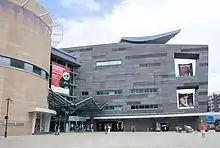 | |
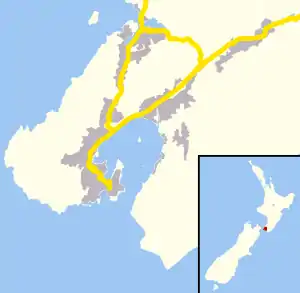 Museum location | |
Former name | Dominion Museum and National Art Gallery |
|---|---|
| Established | 1992 |
| Location | Wellington, New Zealand |
| Coordinates | |
| Visitors | 1.5 million (2017)[1] |
| Director | Courtney Johnston |
| Website | Official website |
Te Papa Tongarewa translates literally to 'Container of Treasures'. A fuller interpretation is ‘our container of treasured things and people that spring from mother earth here in New Zealand’. Te Papa's philosophy emphasises the living face behind its cultural treasures, many of which retain deep ancestral links to the indigenous Māori people. The Museum recognises the partnership that was created by the signing of the Treaty of Waitangi, te Tiriti o Waitangi, in 1840.[3]
WELT is the index herbariorum code for Te Papa.[4]
History
Colonial Museum
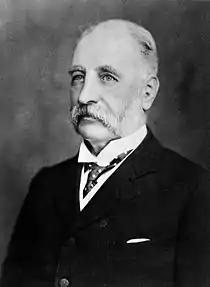
The first predecessor to Te Papa was the Colonial Museum, founded in 1865, with Sir James Hector as founding director. The Museum was built on Museum Street, roughly in the location of the present day Defence House Office Building.[5]
The museum prioritised scientific collections but also acquired a range of other items, often by donation. These included prints and paintings, ethnographic curiosities, and items of antiquity.[6]
In 1907, the Colonial Museum was renamed the Dominion Museum and took on a broader focus. The idea of developing a public art gallery in Wellington was gathering support, and the Science and Art Act of 1913 paved the way for a national art gallery in the same building.
Dominion Museum
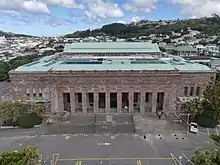
In 1936, a new building to house the Dominion Museum and newly formed National Art Gallery of New Zealand opened in Buckle Street as a part of the newly built National War Memorial. It incorporated the New Zealand Academy of Fine Arts, which sold its land and donated the proceeds to the new organisation.
National Art Gallery
The National Art Gallery was opened in 1936 and occupied the first floor of the National Art Gallery and Dominion Museum building on Buckle Street, Wellington. It was originally populated with a collection donated by Academy of Fine Arts. The Gallery was formed with the passing of the National Art Gallery and Dominion Museum Act in 1930.
Both the Dominion Museum and Gallery were overseen by a single board of trustees. The official opening was by the Governor General in 1934.[7]
The early holding consisted largely of donations and bequests, including those from Harold Beauchamp, T. Lindsay Buick, Archdeacon Smythe, N. Chevalier, J. C. Richmond, William Swainson, Bishop Monrad, John Ilott and Rex Nan Kivell.[8]
Eru D. Gore was secretary-manager from 1936 till his death in 1948 when Stewart Maclennan was appointed the first director. This was the first appointment in New Zealand of a full-time art gallery director. Past directors of the gallery include:
- Stewart Maclennan (1948–68)
- Melvin Day (1968–78)
- Luit Bieringa (1979–89)
- Jenny Harper (1990–92)
Te Papa
Te Papa was established in 1992 by the Museum of New Zealand Te Papa Tongarewa Act 1992.[9] Part of the remit for Te Papa was to explore the national identity of New Zealand.[10]
The official opening took place on 14 February 1998, in a ceremony led by Prime Minister Jenny Shipley, Sir Peter Blake, and two children. The first chief executive of the Museum was Cheryll Sotheran. Māori traditional instrumentalist Richard Nunns co-led the musicians at a dawn ceremony on opening day.[11]
The museum is run by a board appointed by the Minister for Arts, Culture and Heritage. Board members have included: Wira Gardiner, Fiona Campbell, Sue Piper, Judith Tizard, John Judge, Miria Pomare, Michael Bassett, Christopher Parkin, Sandra Lee, Ngātata Love, Ron Trotter, Glenys Coughlan, Judith Binney, Philip Carter, and Wendy Lai.[12]
The museum had one million visitors in the first five months of operation, and between 1 and 1.3 million visits have been made in each subsequent year. In 2004, more space was devoted to exhibiting works from the New Zealand art collection in a long-term exhibition called Toi Te Papa: Art of the Nation.[13] Filmmakers Gaylene Preston and Anna Cottrell documented the development of Te Papa in their film Getting to Our Place.[14]
CEOs of Te Papa include:
- Cheryll Sotheran (1992–2002)
- Seddon Bennington (2003 – July 2009)
- Michael Houlihan (Aug 2010 – May 2014)[15]
- Rick Ellis (Nov 2014 – May 2017)[16][17]
- Geraint Martin (May 2017 – 2019)[18][17]
- Courtney Johnston (2019–present)[19]
The museum has sometimes been the centre of controversy. The siting of significant collections at the water's edge on reclaimed land next to one of the world's most active faults has resulted in concern by some people. There has been criticism of the 'sideshow' nature of some exhibits, primarily the Time Warp section, which has closed. There has also been criticism that some exhibits were not given due reverence. For example, a major work by Colin McCahon was at one stage juxtaposed with a 1950s refrigerator in a New Zealand culture exhibition.[20]
New Zealand art commentator Hamish Keith has been a consistent critic of Te Papa at different times referring to it as a "theme park", the "cultural equivalent to a fast-food outlet" and "not even a de facto national gallery",[21] but seemed to moderate his opinion later when making a case for exhibition space on the Auckland waterfront.[22]
Staff restructuring at Te Papa since 2012 has generated significant controversy.[23][24][25] In October 2018, Te Papa management promised to review restructuring plans, indicating that plans would be scaled back.[26] In February 2019, the Collection Manager of Fishes Andrew Stewart and the Collection Manager of Molluscs Bruce Marshall were made redundant.[27][28][29] Numerous museum experts and scientists in New Zealand and worldwide criticised the move, with researchers including Steve O'Shea advocating a boycott.[30][31][32][33][34][35][36][37][38] In March 2019, the redundancies were delayed.[39] In April 2019, the Museum reversed the decision for Andrew Stewart, offering him an alternative job.[40][41][42] Between April and May 2019, Te Papa advertised a research position for a molluscan curator and awarded the job to an alternative candidate to Bruce Marshall.[39][43][44] The advertisement and decision to not offer the job to Bruce Marshall was criticised harshly by outside experts,[39][43] prompting moa expert Trevor Worthy to end his 30-year research association with the museum in protest.[45]
Current building
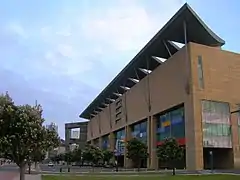
The main Te Papa building is built on former Wellington Harbour Board land, on the waterfront in Wellington, on Cable Street. The building contains six floors of exhibitions, cafés and gift shops dedicated to New Zealand's culture, history and environment. The museum also incorporates outdoor areas with artificial caves, native bushes and wetlands. A second building on Tory Street is a scientific research facility and storage area, and is not open to the public.
Te Papa was designed by Jasmax Architects[46] and built by Fletcher Construction.[47] The 36,000-square-metre (390,000 sq ft) building had cost NZ$300 million by its opening in 1998. Earthquake strengthening of the Cable Street building was achieved through the New Zealand-developed technology of base isolation,[48] essentially seating the entire building on supports made from lead, steel and rubber that dampen the effect of an earthquake.
The site was previously occupied by a modern five-storey hotel. This was jacked off its foundations onto numerous rail bogies and transported 200 metres (660 ft) down and across the road to a new site, where it is now the Museum Hotel.
Collections
The History Collection includes many dresses and textiles, the oldest of which date back to the sixteenth century. The History Collection also includes the New Zealand Post Archive with around 20,000 stamps and related objects, and the Pacific Collection with about 13,000 historic and contemporary items from the Pacific Islands.
There are significant collections of fossils and archaeozoology; a herbarium of about 250,000 dried specimen; a collection of about 70,000 specimen of New Zealand birds; significant amphibians, reptiles and mammals.
The museum has the world's largest specimen of the rare colossal squid (Mesonychoteuthis hamiltoni). It weighs 495 kilograms (1,091 lb) and is 4.2 metres (14 ft) long.[49] The squid arrived at the museum in March 2007 after being captured by New Zealand fisherman in the Ross Sea off Antarctica.[50] The cultural collections include collections on photography, Māori taonga (cultural treasures), and Pacific cultures.
The Museum of New Zealand is also home to the Elgar Collection a valuable collection of English and French furniture and paintings the oldest of which date back to the seventeenth century. In 1946 the Dominion Museum one of Te Papa's predecessors received a bequest of some Fernside Homestead’s finest antiques from Ella Elgar’s will. Until 1992 these antiques were displayed in period rooms at the Museum but today objects from the Elgar Collection can be seen in many exhibitions at the museum.[51]
Archives
The Archives are located in a separate building on 169 Tory Street and are open for researchers on appointment. There are two categories of archive collections: the museum archive and the collected archives.
The Museum Archive goes back to the founding of the Colonial Museum in 1865 and that comprise the archives of James Hector. The archives of the National Art Gallery of New Zealand are also part of these archives. The Collected Archives fall into two groups:
- Art-related records and other archival papers in specialist areas; for instance the archives of Toss Woollaston, Lois White and Leonard Mitchell)
- A wide variety of archival material, that include the diary of Felton Mathew, Surveyor General at the time of the signing of the Treaty of Waitangi, and battle plans and correspondences related to World War I; for instance the Gallipoli diary of Captain E.P. Cox.[52]
Exhibitions
Te Papa has a mixture of long term exhibitions of cultural objects, hands-on and interactive exhibitions, cultural spaces and touring exhibitions. The long term exhibitions of cultural objects focus on New Zealand history, Māori culture and New Zealand's natural world. The hands-on and interactive exhibitions focus on engaging particularly young visitors and include both indoor areas and out-door areas built and planted for the purpose. The key cultural space is the Te Hono ki Hawaiki marae with very impressive whakairo.[53]
All permanent exhibitions are free. Many of the touring exhibition are ticketed, but there are occasional free days.[54]
In 2018, the Mountains to Sea and Awesome Forces exhibits were closed, with Te Taiao Nature taking their place. This new exhibit opened on the 11th of May 2019, with a 1,400 square-metre exhibition focussing on New Zealand's natural environment.[55] The exhibition retains several features of the old exhibits, such as an earthquake simulation and a 495 kilogram (1,091 lb) Colossal squid.
A full list of exhibitions can be found here.
Library
Te Aka Matua Library, previously a publicly accessible library, is now open only to researchers by appointment between 10am-5pm, Monday-Friday. The library is a major research and reference resource, with particular strengths in New Zealand, Māori, natural history, art, photography and museum studies. It is located on the fourth floor of the main building.[56]
Mahuki Innovation Accelerator
Mahuki[57] is Te Papa's innovation accelerator. It is an in-residence programme in which 10 teams develop solutions to challenges facing cultural institutions.[58]
Controversies
Virgin Mary artwork controversy
British artist Tania Kovats’ exhibition, Pictura Britannica, depicting the Virgin Mary in a condom, infuriated many in the Christian, Muslim and Jewish community and sparked protests and counter protests a month after Te Papa opened its doors in 1998.[59] A nationwide petition was circulated calling for the work’s removal. Protesters congregated on the forecourt outside, increasing in number after The Christian Action group took out a full-page advertisement in The Dominion newspaper inviting people to join their protest. They threatened to take Te Papa to court on the grounds of ‘blasphemous libel’, a 1961 Crimes Act offence against ‘religion, morality and public welfare’. Te Papa staff also became the target of abusive and threatening phone calls and letters. The exhibit was guarded after being physically attacked, and following that, a guard working at the site was assaulted.
Te Papa responded by refusing to remove the offending artwork. The museum welcomed protestors back, stating that the museum’s aim was not to offend, but to stimulate debate as a forum. However, they stipulated that debate would not concern the removal of the artwork, but only its meanings and interpretation, claiming that, ‘the people of New Zealand would want the museum to take a strong position on this, not to succumb to intimidation as some other museums have’. The move sought to align Te Papa with other art museums that have taken the side of artistic freedom in spite of well publicised protest (the statuette was banned in Adelaide, stolen in Sydney, and dropped from its British tour).Though ostensibly positioning itself as neutral space for debate, Te Papa’s stand was nonetheless political. It communicated the institution’s liberal credentials that associate secularism with institutional progressiveness.
The leader of the Christian Heritage Party claimed that the sacrilegious display of the statuette was hypocritical, given that the museum is careful not to offend sensitivities about Maori spirituality.
Behind the scenes tour advice for women
Advice for pregnant and menstruating women to avoid a behind-the-scenes tour of some of Te Papa's collections in 2010 had some questioning if this was appropriate inclusiveness for a national museum. A Te Papa spokeswoman at the time said the policy was in place because of Māori beliefs surrounding the taonga collection included in the tour "for their own safety".[60] This generated outrage, with claims that Te Papa was overbearing in terms of political correctness.
William Strutt painting dispute
Taranaki tribal elders raised objections to a 19th century Te Papa-owned painting that the museum planned to lend to the Govett-Brewster Art Gallery in New Plymouth in 2019. Te Papa said it hoped the piece, View of Mt Egmont, Taranaki, New Zealand, taken from New Plymouth, with Maoris driving off settlers' cattle, would spark a conversation about historical perspectives.
Te Taiao water quality falsification
In 2019, the museum faced criticism from farmers, and National Party MP Todd Muller over a container of brown dyed water which was part of a display in the museum's Te Taiao Nature exhibition. This water was labelled as "water from a typical farm stream" with an image of a cow defecating in a waterway, and was classed as undrinkable.[61] Te Papa spokeswoman Kate Camp also told Stuff that the bottles had been created for display purposes only and were not samples. Camp stated:
- "This display is about telling the story of New Zealand waterways. It's based on robust research that shows that many waterways in New Zealand – in urban and rural areas – aren't fit to drink or to swim in."
Exposure of adult content to children
In 2020, several children were exposed to mature content without sufficient warning messages. Te Papa head of art Charlotte Davy said the museum would this be making warning signs more obvious and installing new ones.
See also
- Rongomaraeroa, the contemporary marae of Te Papa
- New Zealand Dominion Museum building
- Tales from Te Papa, a television series about objects from the collection
References
- "Cultural sector overviews, history". Manatū Taonga. 12 January 2018. Retrieved 23 March 2018.
- "Te Papa founding chief executive Dame Cheryll Sotheran dies after long illness". Stuff. 31 December 2017. Retrieved 14 February 2018.
- Museum of New Zealand Te Papa Tongarewa Souvenir Guide. Wellington, New Zealand: Te Papa Press. 2017. pp. 6–7. ISBN 9780994136220.
- "Herbarium List - The William & Lynda Steere Herbarium: Te Papa Tongarewa". sweetgum.nybg.org. Retrieved 9 November 2020.
- "Object: Colonial Museum | Collections Online – Museum of New Zealand Te Papa Tongarewa". collections.tepapa.govt.nz. Archived from the original on 18 June 2015. Retrieved 18 June 2015.
- "Our history". Museum of New Zealand Te Papa Tongarewa, Wellington, NZ. 10 February 2016. Retrieved 8 January 2021.
- "National Art Gallery and Dominion Museum | The Governor-General of New Zealand Te Kawana Tianara o Aotearoa". gg.govt.nz. 1934. Archived from the original on 22 May 2010. Retrieved 18 October 2011.
14 Apr 1934
- "National Art Gallery Wellington – Te Ara: The Encyclopedia of New Zealand". teara.govt.nz. 2011. Archived from the original on 23 October 2012. Retrieved 18 October 2011.
- "Museum of New Zealand Te Papa Tongarewa Act 1992 No 19 (as at 25 January 2005), Public Act – New Zealand Legislation". legislation.govt.nz. 2011. Archived from the original on 27 January 2012. Retrieved 28 July 2011.
- Tramposch, William J. (January 1998). "Te Papa: Reinventing the Museum". Museum Management and Curatorship. 17 (4): 339–350. doi:10.1080/09647779800201704.
- "Biography". The Arts Foundation. Archived from the original on 20 March 2012. Retrieved 24 September 2011.
- "New Te Papa chair and board member appointed". scoop.co.nz. 2010. Archived from the original on 2 February 2014. Retrieved 17 October 2011.
- "Appointment to the Board of Te Papa Tongarewa". scoop.co.nz. 2008. Archived from the original on 2 February 2014. Retrieved 17 October 2011.
- "New appointments to Te Papa board announced". scoop.co.nz. 2009. Archived from the original on 2 February 2014. Retrieved 17 October 2011.
- "Lee and Love appointed to Te Papa Board". scoop.co.nz. 2007. Archived from the original on 2 February 2014. Retrieved 17 October 2011.
- "Appointments to Te Papa Tongarewa Board". scoop.co.nz. 2006. Archived from the original on 3 February 2014. Retrieved 17 October 2011.
- "New appointments to Te Papa Board". scoop.co.nz. 2010. Archived from the original on 6 August 2010. Retrieved 17 October 2011.
- "Toi Te Papa – International and New Zealand Art from Te Papa's collection". www.tepapa.govt.nz. Archived from the original on 2 April 2015. Retrieved 18 June 2015.
- "Getting to Our Place". 17 July 2011. Archived from the original on 17 July 2011. Retrieved 18 June 2015.
- Burgess, Doug (27 November 2014). "Te Papa lifts lid on ex-CEO". Stuff. Retrieved 9 September 2019.
- "Te Papa appoints new Chief Executive". Museum of New Zealand Te Papa Tongarewa. 10 November 2014. Retrieved 9 September 2019.
- Macdonald, Nikki (19 October 2019). "Who should Te Papa choose to lead the national museum?". Stuff. Retrieved 19 October 2019.
- "Te Papa chief executive Geraint Martin quits after controversial restructure". New Zealand Herald. 9 September 2019. Retrieved 9 September 2019.
- "New Chief Executive Courtney Johnston will lead Te Papa into a new era". Museum of New Zealand Te Papa Tongarewa. 13 December 2019. Retrieved 14 December 2019.
- Williams, Paul (May 2001). "Parade: Reformulating Art and Identity at Te Papa, Museum of New Zealand" (PDF). Open Museum Journal Volume 3: Policy and Practice. Archived from the original (PDF) on 10 April 2008. Retrieved 27 March 2008.
- Keith, Hamish (22 March 2008). "Te solution (Cultural Curmudgeon)". New Zealand Listener. 213 (3541). Archived from the original on 10 August 2012. Retrieved 28 September 2012.
- Keith, Hamish (5 December 2011). "Hamish Keith on museums". New Zealand Listener (3734). Archived from the original on 11 August 2012. Retrieved 28 September 2012.
- "Is Te Papa properly managing its collections?". Stuff.co.nz. Retrieved 11 April 2019.
- "Te Papa lacking enough internal staff to look after entire collection, experts say". Stuff.co.nz. Retrieved 11 April 2019.
- "A review panel for collection management at the museum was not made aware of restructuring plans". Radio New Zealand. Retrieved 11 April 2019.
- "Te Papa restructure: 'A really thorough root and branch review'". Radio New Zealand. Retrieved 11 April 2019.
- "Te Papa restructure risks loss of irreplaceable science expertise – critics". Stuff.co.nz. Retrieved 15 February 2019.
- "World-leading science experts made redundant in Te Papa restructure". Stuff.co.nz. Retrieved 15 February 2019.
- "World renowned experts set to be made redundant by Te Papa, insider says". Radio New Zealand. Retrieved 15 February 2019.
- "Nic Rawlence: Te Papa's latest restructure is a great leap backwards". New Zealand Herald. Retrieved 11 April 2019.
- "Te Papa defends natural history team restructure". Radio New Zealand. Retrieved 11 April 2019.
- "Scientist worried for Te Papa's biological collections". Radio New Zealand. Retrieved 11 April 2019.
- "Scientists have growing concern for Te Papa's natural history collection". Radio New Zealand. Retrieved 11 April 2019.
- "Te Papa must decide if it still wants to be a natural history museum". The Spinoff. Retrieved 11 April 2019.
- "The loss of knowledge behind the scenes at the museum". Stuff.co.nz. Retrieved 11 April 2019.
- "Te Papa slammed by 30 international experts over restructure making scientists redundant". Stuff.co.nz. Retrieved 11 April 2019.
- "Global fish experts could boycott Te Papa over scientist job cuts". Stuff.co.nz. Retrieved 11 April 2019.
- "Another 20 international fish experts sign petition against Te Papa restructure". Stuff.co.nz. Retrieved 11 April 2019.
- "Te Papa museum lists ad for new curator after expert made redundant". Radio New Zealand. Retrieved 11 April 2019.
- "Te Papa backs down over fish expert redundancy". Stuff.co.nz. Retrieved 11 April 2019.
- "Te Papa expert made redundant offered new role at museum". Scoop.co.nz. Retrieved 11 April 2019.
- "Te Papa offers new job to scientist it made redundant". Wellington Scoop. Retrieved 11 April 2019.
- "Te Papa seeking mollusc specialist after axing world-leading expert". Stuff.co.nz. Retrieved 11 April 2019.
- "World-leading Te Papa mollusc expert misses out on curator job". Stuff.co.nz. Retrieved 25 May 2019.
- "Mr Moa scientist cuts 30-year Te Papa connection over staff treatment". Stuff.co.nz. Retrieved 11 April 2019.
- "Jasmax". Archived from the original on 9 December 2017. Retrieved 8 December 2017.
- "Building". Fletcher Construction. Archived from the original on 25 May 2010. Retrieved 28 April 2010.
- "Base Isolation" (PDF). Archived from the original (PDF) on 19 March 2013. Retrieved 10 April 2013.
- Atkinson, Kent (1 May 2008). "Size matters on 'squid row'". The New Zealand Herald. Retrieved 25 September 2011.
- "Colossal squid may be headed for oven". USA Today. AP. 22 March 2007. Retrieved 17 January 2015.
- "Fernside, the Elgar homestead". Te Papa Collections online.
- "Object: Diary, Gallipoli | Collections Online – Museum of New Zealand Te Papa Tongarewa". collections.tepapa.govt.nz. Archived from the original on 10 October 2015. Retrieved 18 June 2015.
- "Meeting house, Te Papa Tongarewa – First peoples in Māori tradition – Te Ara: The Encyclopedia of New Zealand". teara.govt.nz. 2011. Archived from the original on 18 March 2012. Retrieved 17 October 2011.
These carvings are on Te Hono ki Hawaiki wharenui (meeting house) in Te Papa museum. They show links to Hawaiki, the spiritual homeland from which the first arrivals to New Zealand came.
- "See Te Papa's masterpieces for free". scoop.co.nz. 2011. Archived from the original on 27 January 2011. Retrieved 17 October 2011.
Wellingtonians have the opportunity to see Te Papa’s latest temporary exhibition – The European Masters – on Thursday 3 February for free, thanks to Wellington City Council’s sponsorship of the museum.
- "Ground-breaking nature zone opens in May". Te Papa. 18 February 2019. Retrieved 29 May 2019.
- "Research library and reading rooms". Museum of New Zealand Te Papa Tongarewa. 10 February 2016. Archived from the original on 27 March 2018. Retrieved 28 March 2018.
- Murphy, Oonagh (1 January 2018). "Coworking Spaces, Accelerators and Incubators: Emerging Forms of Museum Practice in an Increasingly Digital World" (PDF). Museum International. 70 (1–2): 62–75. doi:10.1111/muse.12193. ISSN 1350-0775. S2CID 166015542.
- "Open Minds. Open Markets". Mahuki. Retrieved 29 May 2019.
- "Our Place needs biculturism not biased culturism". stuff.co.nz. 2011. Retrieved 17 October 2011.
- "Pregnant women warned off Te Papa tour". Stuff. 12 October 2010. Retrieved 8 January 2021.
- "'Outrageous': Farmers furious over Te Papa 'dirty water' display". Newshub. Retrieved 8 January 2021.
External links
| Wikimedia Commons has media related to Te Papa Tongarewa. |